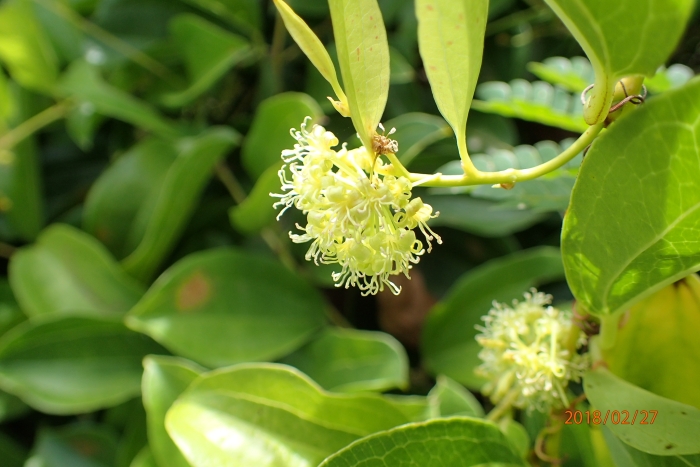Wild Sarsaparilla
(Smilax anceps)
Wild Sarsaparilla (Smilax anceps)
/
/

Peter Warren
Public Domain
Image By:
Peter Warren
Recorded By:
Copyright:
Public Domain
Copyright Notice:
Photo by: Peter Warren | License Type: Public Domain | License URL: http://creativecommons.org/publicdomain/zero/1.0/ | Rights Holder: Peter Warren | Publisher: iNaturalist | Date Created: 2018-02-27T09:29:23-08:00 |












































Estimated Native Range
Summary
Smilax anceps, commonly known as Wild Sarsaparilla, is an evergreen perennial herb or vine native to a variety of habitats including tropical and subtropical forests, savannahs, and thickets in Sub-Saharan Africa, the Comoros, and the Indian Ocean Islands. It can grow to a height of 4 feet (1.2 meters) and spread widely, up to 15 feet (5 meters). The plant features tendrils that allow it to climb over other vegetation, and it has a sprawling habit that can cover a large area. The leaves are heart-shaped, glossy, and have a leathery texture. Smilax anceps produces small, inconspicuous yellow, green, and white flowers during the summer, which are typically not grown for their ornamental value.
Wild Sarsaparilla is valued for its vigorous growth and dense foliage, which makes it an excellent ground cover or climbing plant in tropical and subtropical gardens. It is also used for its medicinal properties, as various parts of the plant are used in traditional medicine. In cultivation, it prefers full sun but can tolerate partial shade, and it requires medium amounts of water. It is adaptable to a range of soil types, provided they have good drainage. While not typically prone to serious diseases or pests, it can become invasive if not managed properly, spreading aggressively through its rhizomes. Gardeners should be cautious when planting it near natural areas to prevent unwanted spread.CC BY-SA 4.0
Wild Sarsaparilla is valued for its vigorous growth and dense foliage, which makes it an excellent ground cover or climbing plant in tropical and subtropical gardens. It is also used for its medicinal properties, as various parts of the plant are used in traditional medicine. In cultivation, it prefers full sun but can tolerate partial shade, and it requires medium amounts of water. It is adaptable to a range of soil types, provided they have good drainage. While not typically prone to serious diseases or pests, it can become invasive if not managed properly, spreading aggressively through its rhizomes. Gardeners should be cautious when planting it near natural areas to prevent unwanted spread.CC BY-SA 4.0
Plant Description
- Plant Type: Vine
- Height: 2-3.5 feet
- Width: 10-15 feet
- Growth Rate: Moderate
- Flower Color: Yellow, Green
- Flowering Season: Summer
- Leaf Retention: Evergreen
Growth Requirements
- Sun: Full Sun
- Water: Medium
- Drainage: Slow, Medium, Fast
Common Uses
Bank Stabilization, Bee Garden, Bird Garden, Butterfly Garden, Edible*Disclaimer: Easyscape's listed plant edibility is for informational use. Always verify the safety and proper identification of any plant before consumption., Low Maintenance
Natural Habitat
Tropical and subtropical forests, savannahs, and thickets
Other Names
Common Names: Smooth Carrionflower
Scientific Names: , Smilax anceps, Smilax kraussiana, Smilax goudotiana, Smilax telfaireana, Smilax cynodon, Smilax lessertiana, Smilax anceps var. boutonii, Smilax anceps var. semiamplexicaulis, Smilax borbonica
GBIF Accepted Name: Smilax anceps Willd.